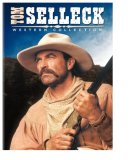| Reviews & Columns |
|
Reviews DVD TV on DVD Blu-ray 4K UHD International DVDs In Theaters Reviews by Studio Video Games Features Collector Series DVDs Easter Egg Database Interviews DVD Talk Radio Feature Articles Columns Anime Talk DVD Savant Horror DVDs The M.O.D. Squad Art House HD Talk Silent DVD
|
DVD Talk Forum |
|
|
| Resources |
|
DVD Price Search Customer Service #'s RCE Info Links |
|
Columns
|
|
|
Tom Selleck Western Collection (Last Stand at Saber River, Crossfire Trail, Monte Walsh)
Warner Bros. has gather together three terrific Tom Selleck small-screen westerns (previously released on DVD) for the appropriately titled Tom Selleck Western Collection, featuring 1997's Last Stand at Saber River, 2001's Crossfire Trail, and 2002's Monte Walsh. No extras here to speak of, but fans of the genre will be pleasantly surprised by the quality of these TV oaters, particularly if they're seeing them for the first time. Selleck has had a long history with the TV western, and these later efforts show his increasing range and comfort within the genre. I'm a big fan of this actor; as I've written before, he has a presence and weight about him that reminds me of actors from an earlier period of Hollywood filmmaking (actors like Gable and Mitchum and Heston). So it's appropriate that he would excel in a genre that seems, no matter how many times filmmakers revisit it, to also belong to an earlier (and better) period of filmmaking. Let's look at the individual films.
LAST STAND AT SABER RIVER
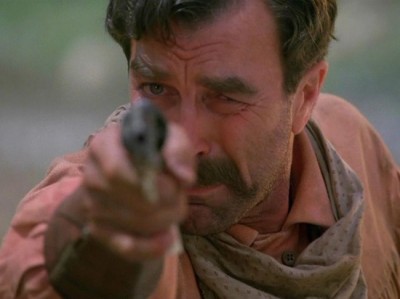
Tom Selleck plays Paul Cable, an ex-Confederate cavalryman who, in 1865, returns to his home and family in Texas. His homecoming is a shock to everyone, though, since it was widely reported that he had died in battle (in fact, he was shot in the backside). His reunion is problematic, though. His wife, Martha (Suzy Amis), is still resentful that Paul volunteered to go off to war (as a personal favor to General Nathan Bedford Forrest), particularly since he wasn't there when his baby girl Mary died of pneumonia. His daughter Clare (Rachel Duncan) is happy to see her father return, but young son Davis (Haley Joel Osment) doesn't recognize his dad. Wishing to go back home to their spread in Arizona (Martha had moved to Texas to be with her father, James Sanford, played by Harry Carey, Jr.), Paul gathers up the clan and heads west.
Unfortunately, once he gets close to their valley, he's stopped by brothers Vern and Duane Kidston (Keith and David Carradine). Both warn Cable and his family not to stick around - particularly since the brothers are Union sympathizers running horses to the nearby Union calvary fort. They know of Cable and where his sympathies lie, although Cable is quick to point out that he didn't fight the war for slavery, but out of duty to his nation. Cable gets little help from Edward Janroe (David Dukes), the man who took over the trading post where Cable's friend Luz (Lumi Cavazos) stays. Janroe offers Cable the chance to aid the Confederacy (by running guns up from Mexico to be shipped East), even though Cable has bluntly stated that the war, for him at least, is over. What follows, then, is an increasingly violent saga of Cable and his family trying to hold onto their homestead, while their enemies gather to throw them out. Or kill them all.
SPOILERS ALERT!
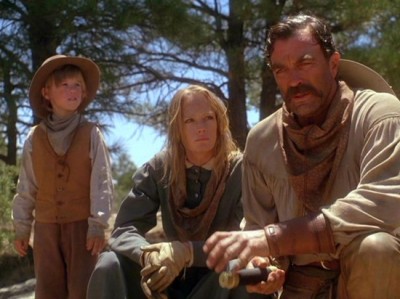
Directed by Dick Lowry (a veteran TV director who helmed, among many other titles, two extremely entertaining cable movies based on murderess Betty Broderick) and written by Ronald M. Cohen (The Good Guys and the Bad Guys), Last Stand at Saber River sports a beautifully clean, integrated story by Elmore Leonard that delivers the western goods fans crave with these kinds of films, while providing layered characterizations that give the action sequences a believable underpinning of motivation. The returning war vet, unrecognized by his children and welcomed back with less-than-open arms by a disillusioned spouse, wasn't exactly an original theme when Leonard wrote it, but the Paul Cable character fits in well with the classic American western hero who only wishes to be left alone with his family, playing fair in fights even when it's to his detriment later on (several times, Cable has a chance to kill one of his tormentors but he doesn't - an attitude that will save his life later on). Having seen enough of war, he now wants no part of killing - unless it's to defend his family or himself. Tormented by his memories of the Fort Pillow massacre (which he witnessed but did not partake in), he resists at every turn the opportunity to become a killer again. His wife Martha, however, an expert with guns since her father was a gunsmith, isn't in the traditional mold of most western heroines. Fast with a weapon (indeed, she draws first blood, killing two members of the gang, when Cable is drawn upon), Martha's pain resulting from losing her child isn't easy swept away by Cable's return. She's angry, and regardless of his initial happiness at his return, that resentment isn't going to go away.
Unusual, too, is the treatment of the villains in Last Stand at Saber River. Certainly the lesser cretins who make up the Kidston gang are serviceably vile, deserving their fate at the end of a gun. But both Duane and Vern are drawn as conflicted men still honoring the code of fair play even when they both aim to kill Cable and his family. Duane, the former Union soldier, waves off the enraged Janroe (unaware that Janroe will kill him to set up Cable as his murderer), contemptuous of the secret Confederate gun runner when Duane learns that the Civil War has finally ended. The screenplay suggests he would have likely dropped the whole matter with Cable, had he lived. Vern as well can't operate like the common killers he employs; when Vern has a clear shot at an unsuspecting Cable, he doesn't take it. He can't kill in cold blood, with his victim unaware of his presence. And indeed, Vern soon figures out that Cable was not behind the murder of his brother, and actually joins forces with Paul to find his kidnapped daughter.
Beautifully and cleanly shot by Lowry, Last Stand at Saber River has a simplicity of visual design that matches the well-integrated, linear script. Staging his action scenes, Lowry keeps the viewer informed on where everyone is during a shootout (something you don't see in a surprising number of action films), and there's an understated realism to the shootings and beatings that's admirable. There's a marvelous score by one of my favorite film composers, David Shire (The Taking of Pelham One Two Three), that works perfectly with the impressive vistas captured by cinematographer Ric Waite (The Long Riders). And the cast is quite good, too. It's great to see the Carradine boys back together again in a western (again, The Long Riders); they're ideally suited for portraying these kinds of complex "villains." And of course, Selleck - taciturn, resolute, and solid as a mountain - is perfect as the conflicted Paul Cable. He handles those horses and guns like he was born to them, and that's more than half the battle with making a western character come alive.
CROSSFIRE TRAIL
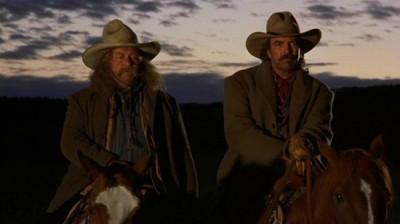
It's 1880, and off the California coast, a mutiny is afoot aboard a tramp steamer. Rafe Covington (Tom Selleck), avenging the beating death of his friend Charlie Rodney (Michael O'Shea) by the ship's captain, in turn beats up Captain Gorgan (Mark Acheson), and jumps ship with friends J.T. Langston (Christian Kane) and Rock Mullaney (David O'Hara). Journeying to the Wyoming ranch owned by Charlie, Rafe (along with J.T.) keeps a promise he made to his dying friend: watch out for his wife, Anne (Virginia Madsen), and for his ranch. Arriving at the frontier town located outside the ranch, he finds good reason for Charlie's concern.
Meeting Anne by accident, he discovers that everyone in town believes Charlie was killed by a Sioux warring party over a year ago - including Anne, who calls Rafe a liar when he tells her what really happened to Charlie. Certainly Bruce Barkow (Mark Harmon), wants that story to hold up. Owner of the local saloon, Barkow is intent on marrying Anne...and getting his hands on her ranch. His henchman, Snake Corville (Marshall R. Teague), knows the story is false, and the town's sheriff, Walter Moncrief (Barry Corbin), is bought and paid for by the evil Barkow. Aided by crotchety old sidekick Joe Gill (Wilford Brimley) and the return of Rock Mullaney, Rafe, getting closer to the truth of why Bruce wants the ranch, must face not only the psychotic Barkow, but also his hired assassin, Bo Dorn (Brad Johnson), who's brought in from Kansas to settle the score with Rafe, once and for all.
SPOILERS ALERT!
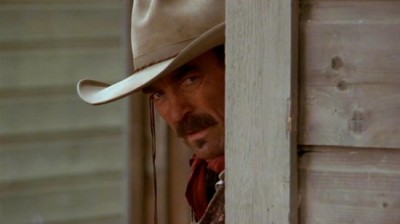
In a noticeable shift in tone, Crossfire Trail eschews the more somber, character-driven structure of Last Stand at Saber River to deliver a more audience-pleasing, rip-snorting actioner, skipping over any serious motivation to get right to the gunplay. Directed by Simon Wincer, who in addition to directing the landmark TV western Lonesome Dove, directed Selleck in one of his best cinematic outings, Quigley Down Under, Crossfire Trail has an agreeably broad, outsized feel to it that has more to do with telling a far-fetched western tale, complete with all the conventions of a standard B-oater, rather than aiming for any serious dramatic impact. Wincer directs this with a big-screen eye, giving Crossfire Trail an epic (but at the same time, a colorful, almost cartoonish) feel that's quite different from the other two films in this collection.
Based on the novel by Louis L'Amour, Crossfire Trail has an admirably comedic touch to many of its scenes, further lightening the already action-heavy, character-light story. During the climactic shoot-out, Wincer takes the time to allow Selleck an amusing double-take when psycho Harmon makes a joke about his "wife"(whom he cold-cocked after the forced nuptials, telling his unconscious bride he'd back to finish up later). Wincer even manages a surreal Leone-esque bit during the final gunbattle where, in a three-second shot, he shows the town's postman/barber/undertaker, hiding in a coffin, shutting the coffin lid while saying, "The undertaker is in!" It's a breezy moment among many in the sometimes silly Crossfire Trail (Harmon's "wedding" is a hoot, as is the drunken sheriff waving off gunfire as he rides out of the final fray in disgust), but the convincing action keeps the film grounded in solid B-western territory.
Selleck, looking impossibly solid strolling up to those saloon doors, gets plenty of opportunities to be strong and silent (and funny), and he's aided by a solid cast. Wilford Brimley might have been a good choice for Selleck's sidekick - had the producers not grafted a ridiculously long wig on him (in one scene, where he's wearing a paisley headband, he looks shockingly, hilariously like David Crosby). I would have preferred it if Harmon had a bit more to do here; he's another underrated TV actor who can essay a psycho with the best of them. But his role here is limited (and rather obvious), so we get no chance to see what he can really do (although his scene with bartender Pee Wee (William Sanderson), who cooks a chicken incorrectly for Harmon, is pretty funny). Still, he comes off far better than Brad Johnson, who's more than faintly ridiculous as the sartorially challenged assassin Bo Dorn. If anything knocks Crossfire Trail down a peg from where it should be, is the miscasting of blah Johnson, who summons up no menace nor threat for the sturdy Selleck.
MONTE WALSH
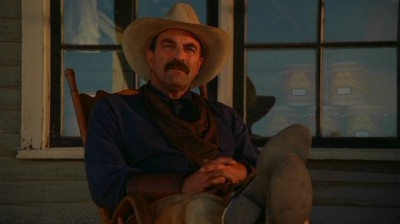
Monte Walsh (Tom Selleck) is part of a vanishing breed of men. It's 1892 in the Wyoming Territory, and cowboys like Walsh - real cowboys with no roots, and no possessions save for a pistol and a saddle - are dying off. Times are hard for the small ranches that are failing due to the harsh winters, and Eastern corporations are buying up land - and fencing it off - faster than the cowboys can comprehend. Walsh's preferred way of living, riding from Texas to Canada and back again during the year, while getting paid for it, is slowly slipping away.
Returning from spending the winter up in a line shack with friend Chet Rollins (Keith Carradine), Monte discovers that ranching jobs have vanished in the face of the Consolidated Cattle company's buying out the remaining spreads. Lucky to get any job with the company's new outfit (headed up by friend Cal Brennan, played by William Devane, whom the company hired to find the very best cowboys), Monte is dismayed that he won't get the coveted bronc-buster job. Even though he's the best, Cal gives the job to younger cowboy, hothead Shorty Austin (George Eads). Finding solace every spring with sympathetic whore "Countess" Martine (Isabella Rossellini), Monte faces the prospect of becoming irrelevant in a world that no longer has any use for men such as he.
Things become even worse when Consolidated Cattle begins to temporarily shut down operations in Wyoming, preferring to just fence off their land and sit on it, rather than work it properly. Shorty is let go, and Monte is offered a job, riding fence (an ignominious job for a real cowboy). Monte, however, has more pressing worries when Shorty, who fell in with the wrong crowd after being let go, becomes a criminal and murderer - a situation Monte feels compelled to resolve.
SPOILERS ALERT!
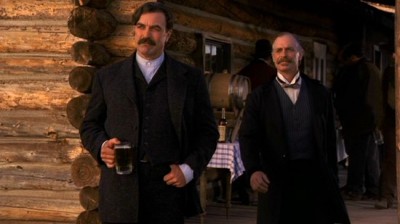
I haven't seen director William A. Fraker's 1970 big-screen version of Monte Walsh in a dog's age (nor have I read the original novel by Jack Schaefer), so I won't draw any comparisons to this cable version, but I will say that I've never seen Tom Selleck shown to better advantage than in this beautifully simple, elegiac western. It's his finest performance, with a character tailor-made to his maturing cinematic persona. Selleck re-teams again with director Simon Wincer, but quite the opposite from their lighthearted, action-packed Crossfire Trails romp, Monte Walsh is a mournful, sad coda for a disappearing West, mirrored in Monte's gradual realization that he has no worth, no place in the changing nature of the land and the country.
Humorous moments do appear in Monte Walsh. The opening sequence (quite expertly paced and directed by Wincer) shows Walsh causing some trouble for an attorney who treats some young boys unkindly; Walsh's practical joke is as much to amuse himself in the jerkwater backstop he finds himself, as it is to "punish" the attorney. There's a riotous, genuinely hysterical sequence where the cowboys, having good-naturedly forced stinky cook Skimpy Eagens (William Sanderson) to take a bath, suffer from diarrhea at the hands of the upset chef, and there's a bunk house fight that winds up in laughter when the participants forget why they were fighting in the first place.
But before and after each of these sequences, scenes of despondency and loss and deep, deep regret bracket them, giving even the humorous scenes a feeling of whistling in the dark for the characters who (already living an isolated, lonely life to begin with) are fighting a losing battle against "progress" and time. The Western as a film genre is almost always grounded in an events-passed, remembrance structure (excluding "modern" westerns), so even the most dynamic, most exhilarating, most action-packed Western with little on its mind, still has a sheen of times long gone, of commemoration of a vanished way of life. What joyful scenes there are in Monte Walsh ultimately feel even sadder when we see how little impact they have on staving back the inevitable melancholy felt by the forlorn cowboys (certainly the tragic suicide of isolated "Fighting Joe" Hooker, played perfectly by James Gammon, illustrates this well).
Indirectly, Monte Walsh also points out the emptiness of the coming corporate culture (epitomized by Consolidated Cattle's odious Robert Slocum, nicely played by John Michael Higgins), where the individual means nothing, and his life, his way of living, connect in no way with his work or his means (perhaps this was why the western proved so popular during that most openly pro-corporate decade in America, the 1950s). As well, Monte Walsh gives a nicely layered approach to the film's only major dramatic element - the crimes of Shorty and his eventual death - by refusing to judge the character too harshly as a black-and-white villain. He isn't let off for his crimes. He's guilty, and Monte's sense of justice demands he dies for his crimes. But ultimately we feel pity (not sorrow) for Shorty, who is as lost as the other characters in a frontier that no longer has any use for his talents. Some heavyweight talent worked on the Monte Walsh screenplay (Robert B. Parker, David Z. Goodman and Michael Brandman), and it shows with the film's careful attention to maintain a consistent vision, a glum dirge to the vanishing cowboy way of life.
Selleck, careful to stay limited and small in those scenes that could have been overplayed for pathos, is letter-perfect as the sadly romantic Monte. His scenes with Isabella Rossellini have a genuine spark of chemistry between the two (she looks quite pleased to be playing opposite the manly Selleck); she's such an instinctive, intuitive actor that she brings out the very best in Selleck's romantic scenes. The Monte character is a tough role for any actor to play. He has to first embody some kind of outsized persona, some gravitas (as did Lee Marvin in the 1970 film version) that the viewer can identify with and care about, and can empathize with once the character is established as falling through the cracks of a careless world. And then, that actor has to live up to the sense of tragedy that infuses Monte, who embodies an honorable way of life that, much to his surprise (because he probably never thought of it before), holds no meaning for anyone anymore. Selleck fits the bill on both counts here, and he's simply outstanding.
The DVD:
The Video:
The transfers for the films in the Tom Selleck Western Collection are exactly the same ones from their previous DVD releases. Last Stand at Saber River is presented full screen (as it was originally broadcast back in 1997). Colors are somewhat subdued, and there is noticeable damage at times to the print. Grain is heavy at times during the darker scenes (with blacks not holding their own, either). Crossfire Trail and Monte Walsh are both presented in anamorphically enhanced, 1.85:1 widescreen transfers that show noticeable improvement over the first film. Colors are much more intense, and contrast values are strong. Compression issues do still crop up occasionally, but overall, they're both smart looking transfers.
The Audio:
Last Stand at Saber River and Crossfire Trail are both presented in fat-sounding Dolby Digital English 2.0 Surround stereo mixes (Last Stand also sports stereo French and Spanish language tracks, too). Monte Walsh is presented in a robust Dolby Digital English 5.1 Surround mix, which, although it sounds great, seems strange because this feature has the least opportunities for taking advantage of such a mix. All films sport English subtitles (French on Last Stand and Monte Walsh) and close-captions.
The Extras:
Text cast profiles on Crossfire Trail and text Star/Director/Writer filmographies on Monte Walsh are the only paltry extras for the Tom Selleck Western Collection.
Final Thoughts:
For my American money, there is no more purely, wholly satisfying film genre than the western. We invented it. We excel in it. And the three cable-made small-screen westerns featured in the Tom Selleck Western Collection provide not only the basic guns-'n'-horses pleasures western fans crave, but also a beautifully sad elegy for the vanishing cowboy in Monte Walsh. Selleck and western fans, if they don't already own these DVDs (no need to double-dip if you do; there aren't any new extras or improved transfers), will no doubt find the price just right for this entertaining collection. I highly recommend the Tom Selleck Western Collection.
Paul Mavis is an internationally published film and television historian, a member of the Online Film Critics Society, and the author of The Espionage Filmography.


|
| Popular Reviews |
| Sponsored Links |
|
|
| Sponsored Links |
|
|
| Release List | Reviews | Shop | Newsletter | Forum | DVD Giveaways | Blu-Ray | Advertise |
|
Copyright 2024 DVDTalk.com All Rights Reserved. Legal Info, Privacy Policy, Terms of Use,
Manage Preferences,
Your Privacy Choices | |||||||









